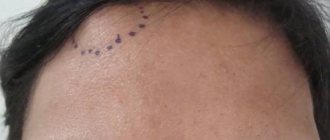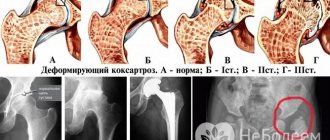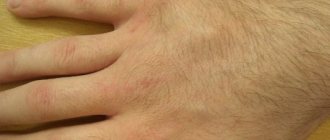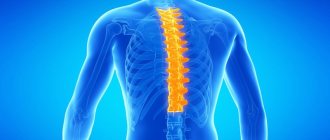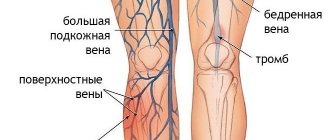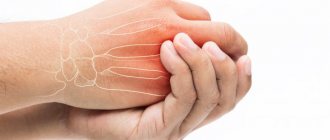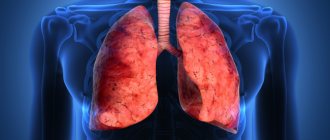Video on the topic:
all videos on the topic
Bone tuberculosis (osteoarticular tuberculosis) is a specific inflammatory disease that occurs in conditions of hematogenous dissemination of the tuberculous process. Tuberculous lesions of bone tissue are most often localized in areas rich in bone marrow (vertebral body, epiphyseal sections of long tubular bones, spongy bones) and are much less common in the diaphyseal sections of short and long tubular bones. When the tuberculosis bacillus penetrates the spongy parts of the bone, a primary lesion (ostitis) occurs, which subsequently spreads to the joints and surrounding tissues, causing their destruction.
The disease can affect various parts of the musculoskeletal system, but most often develops in the spine and large joints (knee, hip, elbow, shoulder and wrist). Complications of tuberculosis of bones and joints, in the absence of adequate treatment, are curvature of the back, the formation of a hump, complete immobility of the joints, muscle atrophy, shortening and paralysis of the limbs.
There are three phases of the disease:
- pre-arthritic phase – formation of a primary lesion (ostitis);
- arthritic phase - the beginning, height and subsidence of secondary arthritis,
- post-aging phase – consequences of tuberculous arthritis (exacerbations, prolonged course, relapses).
Tuberculosis of bones and joints - general characteristics
Every year the number of patients with various forms of tuberculosis increases, while the number of deaths from the disease exceeds the million mark. Osteoarticular tuberculosis, as a severe disease of the musculoskeletal system, firmly ranks second in prevalence after pulmonary tuberculosis.
Although, thanks to the development of medicine, the mortality rate from this disease has been reduced to almost zero, it is important to remember that such bone damage of infectious origin makes patients disabled in 50% of cases.
The occurrence of bone tuberculosis is associated with the penetration of mycobacteria (Koch bacilli) into the body. Often the disease is a consequence of existing damage to the respiratory system.
The pathogen, once in the spongy bone, settles there and forms an inflammatory focus. The disease is accompanied by the formation of fistulas and abscesses in the joints, which can result in complete destruction of bone tissue.
Almost half of the patients are diagnosed with spinal tuberculosis, and:
- in 50% of cases, damage to the thoracic region is diagnosed;
- diseases of the cervical and lumbar vertebrae account for 25% each.
30% – the number of patients whose hip and knee joints are affected. Other bones and joints are rarely infected.
Diagnostics
How to detect bone tuberculosis? To do this, you need to undergo a series of medical examinations. Let's look at each of them.
Visual inspection
Diagnosis of bone tuberculosis cannot be done without consulting a phthisiatrician. An initial examination allows you to identify the first disorders in the musculoskeletal system, determine the location of pain points and signs of general malaise.
Since the human body is completely symmetrical, the healthy half of the body is used to identify abnormalities, the functional ability of the joints, as well as the appearance and activity of the limbs are compared. At this stage, the patient is asked to perform bending exercises - with their help, difficulties in the functioning of spinal segments can be diagnosed. Another sign of bone tuberculosis that is detected during such a consultation is a change in the functioning and sensitivity of the knee reflexes.
Clinical researches
Used to make an initial diagnosis:
- Positive result after Mantoux test;
- Having contact with a carrier of an active form of the disease;
- The appearance of symptoms of intoxication of the body;
- A history of previous infectious diseases;
- Disruption of the affected organ, its deformation and change in structure.
X-ray studies
An x-ray is necessary to confirm the diagnosis. It allows you to identify the features of the development of the disease, determine the degree of destruction of bone tissue and find the exact location of inflammation.
Laboratory research
Using laboratory diagnostics, it is possible to identify the early stages of the disease, at which the symptoms of bone tuberculosis are not yet clearly expressed. This makes it possible to begin timely treatment and minimize possible complications. In addition, laboratory tests allow you to track the effectiveness of the prescribed treatment. If the destruction of pathogenic agents does not occur quickly enough, the doctor increases the dosage of medications or changes the course.
What tests are taken for bone tuberculosis? These include:
- Biopsy;
- Bacterial culture;
- Magnetic resonance imaging;
- General blood analysis;
- Myelography;
- PCR (polymerase chain reaction);
- CT scan;
- ELISA (enzyme-linked immunosorbent assay).
Mycobacteria spread in the human body at an incredible speed, so all biological fluids of the body are taken for study - blood, bone marrow puncture, urine, sputum, etc.
Symptoms and first signs of tuberculosis
The disease in its development goes through three stages, each of which is accompanied by characteristic symptoms.
There are phases:
- primary osteitis (prespondylic);
- progressive osteitis (spondylic);
- post-seniority.
When considering the symptoms of an infectious disease, it is worth paying attention to the fact that the first signs may be almost invisible to the patient. Therefore, in most cases, patients allow the disorder to progress, ignoring the need to consult a doctor.
The initial manifestations of the disease are the presence of:
- weaknesses;
- apathetic state;
- increased drowsiness;
- low-grade fever;
- partial lack of appetite.
In the evening or after physical activity, dull aching muscle pain and increased fatigue are noted. If a person stands or bends, there is painful discomfort in the back, which disappears after rest. The prespondylic phase can last from several weeks to several months.
As the pathology moves to the next stage, the symptoms intensify. The patient begins to experience pain, which is similar to the manifestations of radiculitis or intercostal neuralgia.
The elasticity of the back muscles decreases, the joints become less mobile. At this stage, the disease may be accompanied by signs of intoxication, the severity of which depends on the extent of the tuberculosis process.
Symptoms and first signs of tuberculosis of bones and joints:
- altered gait;
- lameness;
- clubfoot;
- raised shoulders.
When an abscess develops, the area of the joint or vertebra that has become infected swells, and an increase in local temperature is observed. After the formation of a fistulous tract, gray pus is released, which is the most striking manifestation of tuberculous bone lesions.
The last phase is characterized by extinction of the inflammatory process and normalization of well-being. However, the bone tissue can deform further, and the muscles become spasmodic and atrophic. The functioning of bone parts can be restored only with timely treatment.
Tuberculosis of the joints
Tuberculous joint damage from a morphological point of view occurs in 2 forms:
- Infectious inflammation of the joint due to penetration of Koch's bacilli into the articular surface;
- Extra-articular damage in aseptic arthritis (Poncet's disease). Arthritis with this pathology does not appear on an x-ray, which does not allow diagnosing the disease at an early stage.
The first form is characterized by genetic determination. With a deficiency of interleukin-12-interferon gamma, a specific bone lesion develops. Inflammation is accompanied by impaired bone microcirculation, damage to the metaphyses and epiphyses of tubular bones.
Intra-articular damage begins with the formation of small granulomas inside the synovium of the joint. Changes are not visualized on an x-ray. In children, such changes are accompanied by damage to the metaphysis of the growth zone of the bone. On an x-ray, such changes are characterized by an area of reduced bone density. The focus of destruction, lack of blood supply to the damaged area contributes to malnutrition. A favorable environment is created for the proliferation of Mycobacterium tuberculosis.
At an early stage of infection, a destructive lesion with an inflammatory reaction along the periosteum is formed. X-ray examination reveals local destruction with the development of a demineralized area of bone damage.
The first focus of tuberculous lesions is cartilage tissue. It is a barrier to the penetration of foreign microorganisms. When the immune system is weak, the pathological process occurs in 3 stages: pre-arthritic, arthritic, post-arthritic. The clinical and radiological characteristics of the pathology are not determined by specific manifestations, therefore primary bone tuberculosis can be assumed only after an X-ray examination.
Tuberculosis of the joints occurs under the masks of various pains. The picture of spinal tuberculosis is accompanied by an exudative-proliferative component with a characteristic pain syndrome in the back.
The inability to diagnose the pathological process leads to serious errors. With tuberculosis of the joints and spine, the child often receives treatment for juvenile arthritis. The administration of non-steroidal anti-inflammatory drugs leads to the spread of mycobacteria.
We remind you once again that the diagnosis of bone tuberculosis is established on the basis of X-ray examination and tomography. In the initial stages, inflammation of soft tissues indicates a nonspecific inflammatory process.
Tuberculosis of the foot joints is accompanied by destruction without pain. The pain occurs only when walking.
Tuberculous gonitis is characterized by damage to the distal epiphysis of the femur with a clinical picture of proliferative inflammation of grade 2-3. Laboratory signs of infection:
- Positive test for C-reactive protein;
- Settlement rate of more than 60 mm per hour;
- Limitation of movements with an abduction limitation angle of about 10 degrees.
As the clinical picture develops in children, external deformation of the knee joint can be observed. Muscle contracture limits the mobility of the lower limb.
The absence of a soft tissue component leads to problems with clinical diagnosis. Pathology can occur under the guise of bursitis or hygroma. The absence of pain leads to the impossibility of diagnosis at an early stage. With bursitis, it is impossible to conduct even an X-ray examination. The results will be negative.
Tuberculosis is characterized by a slow increase in clinical symptoms. The gonitis occurs without acute pain or signs of fever. The temperature reaction is a pathological sign that allows one to suspect inflammation at an early stage. When comparing the affected joint with a healthy one, deformation and a local increase in temperature can be observed.
Osteoarticular tuberculosis - how is it transmitted, causes, contagious or not
How is bone tuberculosis transmitted? It is better to prevent possible infection than to spend years being treated for unpleasant and painful symptoms.
The infection can be transmitted in several ways:
- Airborne. By sneezing and coughing, the patient infects others, since mycobacteria are present in the secreted sputum. Drops of liquid settle on everything nearby. Infection of a healthy body is possible even during a normal conversation with an infected person.
- Nutritional. The pathogen ends up in the digestive tract along with food containing particles of the patient’s sputum, as well as with the milk and meat of animals infected with Koch’s bacillus.
- Contact. In rare cases, mycobacteria penetrate through the conjunctiva.
- In utero. The child becomes infected as a result of loss of integrity of the placenta.
True, strong immunity is able to eliminate the threat that has arisen, so even if bacteria penetrate the body, they will not cause harm to it. People with weakened immune defenses are at risk.
The disease is provoked by:
- grueling physical activity;
- hypothermia;
- poorly organized nutrition;
- bone injuries;
- recurrence of other infectious diseases;
- living and working in unfavorable conditions;
- prolonged contact with infected people.
You should be careful about communicating with infected people, since the pathogen is quickly transmitted by airborne droplets. The patient's personal hygiene items and items pose a great danger.
Prognosis and prevention
The prognosis for patients with osteoarticular tuberculosis is favorable, subject to proper treatment. Modern methods of therapy and the use of antibacterial drugs minimize the risk of death.
But the disease is quite severe and is accompanied by irreversible bone deformations. Patients with spinal lesions become disabled in half of the cases. Prevention of the disease consists of eliminating contact with tuberculosis patients, preventing injuries and hypothermia, and improving the standard of living. You cannot refuse vaccinations and routine tuberculin tests. Timely identification of sick people and their treatment are necessary.
Bone tuberculosis can be successfully treated. To prevent the process from developing, timely diagnosis and treatment are necessary. Therefore, it is necessary to contact a specialist if pain in the bones and muscles occurs, even if it is mild.
Features of the development of spinal tuberculosis
The most common form is spinal tuberculosis. The pathogen can affect one or more vertebrae. Damage to the thoracic region is often diagnosed, and the inflammatory process usually spreads to two vertebrae.
Depending on the extent of the disease, damage occurs:
- local with the presence of a single focus;
- widespread – 2 or more adjacent segments are involved in the process;
- multiple – 2 or more vertebrae that are not adjacent are infected;
- combined - the infection penetrates simultaneously into the spine and other organs.
The severity of symptoms is influenced by the number of infected vertebrae, the area of formation of the lesion and the stage of the disease. A characteristic sign of pathology is painful discomfort. If bone structures are destroyed, the patient suffers from pain localized deep in the spinal column. It becomes more intense as a result of stress on the musculoskeletal system.
When fragments of the vertebrae compress the nerve roots, the pain radiates to the limbs and torso, while movements are limited and the back muscles become tense.
Allowing the disease to develop, the patient is faced with the formation of abscesses and fistulas with subsequent release of purulent contents. The neglected form results in the formation of a hump due to the destruction of the vertebrae. If the lesion is multiple, the torso is significantly shortened.
Causes
Contact with tuberculosis patients is the main, but far from the only cause of joint tuberculosis. The rapid development of pathology is facilitated by accompanying factors:
- Severe and/or prolonged hypothermia;
- Hard physical labor;
- Unfavorable living conditions;
- Chronic infectious processes;
- Alcohol abuse;
- Poor nutrition, deficiency of microelements and vitamins;
- Frequent injuries of the musculoskeletal system;
- Increased stress on joints and bones.
Distinctive signs of the disease in adults and children
Osteoarticular tuberculosis in childhood occurs somewhat differently than in adults. If an infection enters a child’s body, it covers an area of greater size in a fairly short period of time. Signs of pathology in children are more pronounced.
The disease is often accompanied by the formation of abscesses and fistulas. At the articular ends, large inflammatory foci appear, as a result of which the articular cartilage is destroyed much more severely.
Due to significant damage to the spinal column and joints, it is difficult for the child to move. Moreover, the patient may become bedridden.
The main danger of the disease in childhood is that the musculoskeletal system has not yet fully formed.
Consequently, the bones will develop incorrectly due to infection, which results in:
- the formation of an arched bulge on the back (hump);
- scoliotic and other types of curvature of the spinal column, which may have the last stage.
When infected with Koch bacilli, a child runs the risk of developing a disability, from which it is not possible to get rid of it. Compression by vertebrae or abscesses of the spinal cord can cause paralysis.
Deformation of the spinal column in children causes:
- changes in the location of the bone marrow and internal organs;
- uneven growth of joints in length;
- severe intoxication;
- gradually weakening of the immune system;
- permanent skeletal deformation.
If in adults treatment of tuberculosis is possible without surgery, in childhood it is impossible to do without surgery.
How is it recommended to treat this pathology?
To cure such a serious disease as tuberculosis of the joints and bones it will take a long time, depending on the patient’s condition from 1.5 to 3 years, an integrated approach to the problem.
In the early stages, efforts will be directed toward increasing the body’s defenses and unloading the affected bones and joints.
Rest and relief for the affected organs are provided in various ways, for example, by applying a plaster or splint to a limb, wearing a corset if the spine is damaged, or bed rest until the end of treatment.
In later stages, antibiotic therapy is used for treatment, often in combination with chemotherapy.
It helps to cope with the proliferation of microorganisms and their spread.
If a person’s immunity is strong, the disease subsides and complete recovery occurs. If antibacterial agents do not give the desired effect, then they are used in combination with hormonal agents and chemotherapy.
To shorten the treatment period and completely restore joint function, surgical treatment is used. It is used at any stage of the disease, on any bone or joint, regardless of the extent of the source of infection.
Treatment of osteoarticular tuberculosis
If you become infected with tuberculosis bacilli, you should be prepared for long-term treatment.
It will take 1.5-3 years to restore the body, and complex therapy will be used, the task of which is to:
- cessation of the infectious process;
- preventing further bone destruction;
- complete elimination of the lesion;
- strengthening the immune system.
The patient is given a plaster cast or splints, an orthopedic corset is selected, or bed rest is prescribed.
Based on the examination data, antibacterial drugs are selected for the patient, especially in the presence of stages 2 and 3.
Taking antibiotics makes it possible to:
- slow down the proliferation of mycobacteria;
- stop inflammation;
- avoid complications;
- accelerate the weakening of the tuberculosis process.
Patients are prescribed to take Streptomycin, Isoniazid, Pyrazinamide, Rifampicin, Ethambutol, Kanamycin, Viomycin, Cycloserine.
Antibiotic therapy is often combined with chemotherapy drugs (Tubazid, Ftivazid, Ethionamide, Ethoxide) and hormonal agents (Cortisone, Hydrocortisone).
If conservative methods are ineffective and the disease is rapidly progressing, the patient is prepared for surgery. Surgical intervention is provided at any stage of the disease.
Treatment
In the absence of timely and correct treatment, the pathology leads to curvature of the spine, shortening or paralysis of the limbs, the formation of a hump and disability. To avoid such problems, you need to consult a doctor when the first symptoms of bone tuberculosis appear.
The treatment regimen for this pathology is developed individually for each patient and depends on the diagnostic results, location of the disease and general health. The main goals of therapy are to destroy pathogenic agents, strengthen the immune system and restore lost functions. It is possible to get rid of the disease, but it will take at least 2 years of regular procedures and strict adherence to medical recommendations.
BCG vaccine - is it necessary to vaccinate and is it effective?
When doctors insist on vaccinating their children against tuberculosis infection, parents often have doubts about whether the BCG vaccination is necessary and effective.
Every year the disease affects many people, although vaccinations are given regularly. Therefore, it is not surprising that adults refuse to bring their children for immunization, considering the procedure absolutely useless.
Of course, the BCG vaccination cannot completely protect against infection. But thanks to it, the risk of developing a full-blown disease is significantly reduced, while the vaccine helps prevent the occurrence of severe forms of the disease that often affect babies: tuberculous meningitis and disseminated tuberculosis.
Newborn babies are most at risk of infection. Often in children under one year of age, the brain is affected along with infection of the lungs.
Do not forget that the pathogen is capable of penetrating any organs and causing serious complications, making the child disabled. Therefore, for the first time, immunization against tuberculosis using BCG is carried out 4-7 days after birth.
Unvaccinated children, as statistics show, are 15 times more likely to get tuberculosis. BCG vaccination will be ineffective only when the patient is already infected.
Treatment methods
Treatment of tuberculosis of bones and joints is carried out in specialized anti-tuberculosis dispensaries. In the acute period, patients need bed rest and limited physical activity. Subsequently, regular stay in the fresh air, healthy eating, and giving up bad habits are required. The main treatment is carried out with anti-tuberculosis drugs; if necessary, surgery is prescribed. The duration of treatment ranges from one to three years.
Drug therapy
Mycobacterium is treated with specific anti-tuberculosis drugs:
- PASK;
- Isoniazid;
- Pyrazinamide;
- Amikacin;
- Combutol.
Today, four-component therapy is carried out. The drugs are quite toxic, affect the liver, reduce hearing, cause nausea, stool upset, and allergic reactions. To reduce side effects, vitamins, hepatoprotectors, and antihistamines are simultaneously prescribed.
It is difficult to influence the bone focus of tuberculosis with drugs. Treatment should be long-term, with regular monitoring of blood tests, ultrasound and bone x-rays.
Surgery
Indicated in cases of ineffectiveness of drug therapy and disease progression. Depending on the severity of bone destruction, three surgical techniques are used:
- Radical – the affected bone or joint is completely removed;
- Corrective – the affected area is removed, the bone is shortened;
- Reconstructive – the lesion is removed, the defect is replaced with artificial materials.
Important!
If the bone marrow is affected by Mycobacterium tuberculosis, consultation with a hematologist and immunologist is necessary before surgery.
Diet
Tuberculosis infection leads to increased loss of protein and vitamins. To replenish these substances, patients are prescribed a special diet:
- The calorie content of food increases by a third;
- The content of meat and fish in the diet increases;
- During the recovery period, increased consumption of dairy products is necessary;
- Be sure to include vegetables, fruits, and herbs in your diet.
Small meals and drinking plenty of fluids are recommended.
Methods for eliminating tuberculosis of bones and joints
Massage and exercise therapy
Therapeutic exercises are indicated throughout the course of the disease. It is carried out differently depending on the phase of tuberculosis:
- During the active phase, the affected limb remains motionless. The exercises are aimed at preventing muscle atrophy and joint contractures. Gymnastics uses healthy limbs;
- When the activity of the process decreases, passive exercises are performed on the affected limb. Massage is mandatory;
- During the rehabilitation period, restorative gymnastics are prescribed to regain lost self-care skills.
Gymnastics is carried out with an instructor, and then the person is given a set of exercises for independent practice.
Diagnosis of the disease - how to determine the presence of infection
If a patient contacts a doctor complaining of certain symptoms, diagnosis involves the use of the following types of studies:
- clinical;
- X-ray;
- laboratory
Before definitively determining the disease, the doctor takes into account the existing clinical manifestations and clarifies some points regarding:
- possible contacts with infected people;
- positive Mantoux tests;
- previously occurring infectious diseases;
- intensity of symptoms and time of their onset.
Radiography is the main diagnostic method. During the session, pictures are taken of both affected and healthy areas. Thanks to x-rays, it is possible to see various changes in bones and joints. The existing abscess is shown as a shadow in the image.
In addition to radiography, doctors resort to MRI and CT. Computed tomography is often used to diagnose early stage tuberculosis.
Laboratory methods help establish a final diagnosis. Bacterioscopic examination in rare cases can reveal mycobacteria, so a large role is given to cytological analysis. To carry it out, a puncture of bone tissue, lymph nodes, bone marrow, and joint fluid is performed.
Bone tuberculosis in adults, characteristic symptoms
There are 3 stages of the disease, each with its own symptoms:
- Primary osteitis;
- Secondary osteitis;
- The post-arthritis phase is characterized by exacerbations and relapses.
In adults, at an early stage, symptoms are almost not noticeable.
Performance decreases somewhat, discomfort is felt in the spine, mild pain appears in the back and limbs, which goes away after a short rest.
A person does not pay attention to such symptoms, and the disease moves to the next stage.
At the stage of secondary osteitis, the symptoms will be more pronounced. There are complaints of severe pain in the joints and spine.
The pain is similar to that experienced by a person with intercostal neuralgia or radiculitis. At this stage, the back muscles lose their elasticity and joint mobility is impaired.
Signs of the disease can be seen on x-rays. Distances appear between the joints, the bone structure changes, the surface of the cartilage becomes uneven, and cavities appear in the bone. Affected joints can be identified by the presence of tissue swelling or atrophy.
Prognosis for the development of bone tuberculosis
Currently, the mortality rate from bone tuberculosis is close to zero. But this disease is characterized by a very severe course with the development of irreversible bone deformations, which leads to permanent disability. It has been established that patients become disabled in half of the cases of spinal tuberculosis. Treatment is long-term, many drugs are toxic, but only timely seeking medical help and strict adherence to medical prescriptions will prevent irreversible changes.
Diagnosis of bone tuberculosis
All patients with suspected bone tuberculosis undergo radiography or tomography of the affected organ in two projections. In this case, foci of bone destruction, sequestra, and sometimes shadows from septic abscesses are identified.
X-ray of the lumbar spine. The red circle shows typical bone damage in spinal tuberculosis.
In the presence of abscesses or fistulas, fistulography or abscessography is performed to determine their extent. The cavity of the abscess or fistula is filled with a contrast agent, then a series of images is taken. Microbiological examination of areas of dead bone, abscess contents or fistula tract is very important for making a diagnosis. The discovery of Mycobacterium tuberculosis speaks in favor of bone tuberculosis. A blood test determines all the signs of infectious inflammation: an increase in the number of leukocytes, accelerated ESR, the appearance of C-reactive protein, etc. To confirm the diagnosis, provocative tuberculin tests are also used. Considering the secondary nature of the disease, if bone tuberculosis is suspected, it is always necessary to perform an x-ray of the chest organs, and if there are specific complaints, to conduct an examination of other organs.
Clinical manifestations
TBS spine
Bone tuberculosis in a child with a predominant lesion of the spine (Pott's disease) is most common in practical medicine. Typically, several vertebrae in the lumbar or thoracic region are affected.
This is what the affected vertebrae look like
In the first phase of the pathology, patients complain of general poor health and lack of appetite.
Later the following symptoms appear:
- pain during active movements of the body (especially bending and turning);
- limited mobility in the back;
- curvature of the spine, sometimes the appearance of a hump;
- muscle tension around the affected area;
- abscesses, fistulas on the skin.
Back pain is the first sign of health problems
Important! In case of displacement of the vertebrae, compression of the spinal cord may develop, which causes dangerous symptoms such as paralysis of the limbs and disorders of the pelvic organs.
After active inflammation subsides, spinal deformity persists in the form of kyphosis or scoliosis, sometimes a change in the shape of the chest, muscle atrophy (see photo).
Tuberculous spondylitis
Severe chest deformation
Coxite
TBS of the hip joints is characterized by the involvement of the femoral head and acetabulum in the inflammatory process.
Damage to the hip joint
In the prearthritic phase, children complain of deterioration in health, weakness, pain in the affected area after physical activity.
Note! After a night's sleep or rest, all discomfort disappears, so patients may not see a doctor for a long time.
Then the baby’s condition gradually worsens, his signs of intoxication increase (including fever up to 38.5-39 degrees). The pain in the leg becomes constant and almost unbearable.
Over time, the thigh muscles undergo atrophy, the skin turns red and swells. The formation of fistulas is also common: most often they are located on the thigh, lower back, and perineum. Purulent-necrotic masses can be released from them. As a result, the movement of the limb becomes sharply difficult.
It becomes difficult for the child to walk
Drives
With tuberculous lesions of the knee joint, patients first complain of pain in the leg. Then the unpleasant sensations intensify, movement in the leg becomes sharply difficult and lameness develops. Like other forms of osteoarticular TBS, driving is often accompanied by general manifestations of intoxication.
Knee joint damage
Symptoms
Any bones and joints of the skeleton can be affected by the tuberculosis bacillus. Depending on the location of the lesion, a classification of the disease is constructed.
Classification
The tuberculosis process can affect both bones and joints.
The following forms are distinguished:
- spinal tuberculosis - affects one or more vertebrae;
- hip joint - the acetabulum is mainly affected;
- the knee joint is the most common pathology;
- ankle and foot bones - usually the entire section is affected;
- shoulder joint - a rare disease, the right limb is affected more often;
- wrist - joints and bones are affected;
- elbow joint - a rare pathology, most often develops in adolescence;
- tuberculosis of tubular bones - the metacarpal bones and phalanges of the fingers are affected.
The bones and joints that have a good blood supply are at greatest risk of damage - the forearms, hips, and spine.
Onset of the disease
Osteoarticular tuberculosis develops gradually, almost imperceptibly. The first signs of bone tuberculosis are completely nonspecific and may resemble a cold. The patient feels slight pain in the area where the source of infection is located.
The discomfort becomes stronger after exercise. Minor swelling of the extremities and an increase in body temperature up to 37.5 degrees may be observed. This condition lasts from several weeks to six months.
High period
The main symptoms of osteoarticular tuberculosis develop over the years. During the height of the disease, the clinical picture becomes bright, the symptoms become pronounced. Pain intensifies in the affected area, body temperature rises.
The joints swell, the skin turns red. As the pathology progresses, the patient's condition worsens. The temperature is constantly high - 39-40 degrees. The pain becomes unbearable and cannot be eliminated with painkillers (see also How to eliminate pain in the spine quickly and effectively).
Deformation of joints and bones intensifies, and limitation of mobility increases. Muscle dystrophy develops. Further, the process fades, the joints lose their functions. The clinical picture may vary slightly, depending on the location of the lesion.
Table. Features of symptoms depending on the location of the lesion.
| Damage area | Manifestations |
| Spine The appearance of angular curvature (hump) is caused by deformation of the vertebral bodies. | The disease develops from 4 months. Pain can be of two types:
|
| Shoulder joint Due to muscle atrophy, the shoulder loses its rounded shape | This form is more common in young people. It manifests itself as gradually increasing pain in the shoulder area. The hand gets tired quickly, and mobility becomes limited. The limb moves with the scapula. Over time, ulcers and fistulas form in the joint area. Further development of the disease leads to a change in the shape of the shoulder - it flattens, sinks, and bony protrusions stand out through the skin. |
| Elbow Changes in the shape of the elbow joint affected by tuberculosis | At the height of the disease, the joint swells greatly, the elbow fold is smoothed out, and the joint takes on a spindle-shaped shape (photo). Fistulas form, the muscles of the limb atrophy, and the axillary lymph nodes enlarge. |
| Wrist Joint swelling | The main distinguishing feature of tuberculosis of the wrist joint is significant swelling of the soft tissues. Most often there is a bilateral lesion. May be combined with tuberculosis of the elbow or knee joints. |
| Hip joint Typical position for tuberculous coxitis | In the arthritic phase, the patient feels unbearable pain in the joint. He takes a forced position - the leg is bent and brought to the thigh of the healthy limb. Muscle atrophy forms, the skin fold in the joint area thickens. In the later stages, displacement and dislocation of the hip bone, deformation of the pelvis, and curvature of the spine occur. |
| Knee Formation of fistulas in the joint area | Occurs mainly in young children. It begins suddenly, with severe pain. Pathology affects the condition of the skin. At first, the skin around the joint is pale and shiny. Then fistulas form on it. Another sign of the disease is the depression of the kneecap when pressed. |
| Ankle and foot bones Tuberculosis of the ankle and calcaneus | Due to the close anatomical connection of the ankle joint and the bones of the foot, tuberculosis spreads to both parts. It is characterized by severe pain in the joint, foot when walking, flexion-extension movements, and rotation. The patient tries to lean on his toes when walking. A painful swelling appears in the area of the infection, the muscles atrophy, and the motor functions of the limb are impaired. |
Important! Often bone tuberculosis occurs in waves. Active periods are followed by remission. Symptoms practically disappear, destructive processes are suspended. The patient feels well, but after some time the disease begins to progress with greater force.
Causes and pathogenesis
The main cause of the pathology is the bacteria Mycobacterium tuberculosis. They are slightly curved rods 1-10 microns long and 0.2-0.6 microns wide. They lack the ability to move and do not form capsules or spores. Obligate aerobes, have the properties of alcohol and acid resistance.
Acid-fast bacilli are the main causative agent of tuberculosis.
This is interesting. For many years, tuberculosis has remained one of the social diseases. March 24 (the day when the German microbiologist Robert Koch first isolated the culture of acid-fast bacilli in 1882) was declared by WHO as the Day against this infection.
Infection with mycobacteria can occur through airborne droplets, as well as through dirty hands, food, etc. It is known that the favorite place of localization and pathological activity of the microbe is the lungs - tissues that are maximally saturated with oxygen. Why does bone tissue damage occur?
TBS of the lungs is most often diagnosed
Once in the body, Koch's bacillus spreads through the bloodstream, lingering in certain tissues, including bones. In some cases, secondary infection from an existing inflammatory focus in the lungs is possible.
After hematogenous spread of MBT, they may settle in:
- synovial membrane of the joint;
- epiphyses of bones;
- metaphyses of bones.
Subsequently, small tuberculous foci develop in these tissues, which grow slowly, but over time lead to serious and irreversible changes.
Among them:
- obliteration of the joint cavity;
- creation of fistulas, abscesses;
- ankylosis of the joint.
Pathogenesis of the disease
However, the entry of an infection into the body does not always lead to infection. The state of the child’s immunity and health as a whole plays an important role in pathogenesis.
Tuberculosis often develops against the background of:
- regular excessive load on the musculoskeletal system;
- hypothermia;
- insufficient or unbalanced nutrition;
- injuries;
- concomitant chronic diseases or infections;
- unsatisfactory material and housing conditions;
- prolonged contact with the bacteria excretor;
- severe psychotraumatic situations, stress;
- taking certain drugs that affect the functioning of the immune system (corticosteroids, immunosuppressants).
Often infection occurs against the background of weakened immunity
How does infection occur?
The disease has “social roots” - its spread is strongly influenced by the state of the environment and the level of well-being of the population. There are bacteria excretors - people with the “open form”. When you cough, a huge amount of bacteria is released with sputum, and when you spit, they end up on surrounding objects. They are very resistant, so they can remain in dust for up to 3 months.
With the flow of air, particles of sputum or dust with mycobacteria enter the respiratory system and settle in the lungs. In this case, two scenarios are possible:
- In the normal state of the body, the site of infection is immediately surrounded by leukocytes with the development of limited inflammation. After 4–8 weeks, specific anti-tuberculosis immunity is formed, which is present in 95% of the population.
- When the defenses are weakened, the immune system cannot cope and a tuberculous granuloma is formed in the lung tissue - an area of chronic inflammation with living bacteria.
It is with the second variant of the course that complications associated with the entry of Koch’s bacilli into various organs and tissues are possible.
Joint tuberculosis is divided into childhood and adult.
The causative agent of tuberculosis
The causative agent of tuberculosis was discovered in 1882 by Robert Koch, for which the researcher was awarded the Nobel Prize in 1905. Of the 30 types of mycobacteria, only 3 cause the development of disease in humans - human, bovine and avian. The pathogen is very stable in the external environment: it lives up to 10 years in manure, up to 19 days in the milk of a sick animal, up to 300 days in butter, up to 1 year in frozen meat.
The complex nature of bacterial metabolism ensures resistance and survival in the external environment. A powerful 3-layer shell protects against macrophages, which are the first to fight infections. Under conditions unfavorable for the microbe, they transform into the L-form and remain viable in this form for decades.
Rice. 1. Mycobacterium tuberculosis was discovered by Robert Koch in 1882.
Rice. 2. Pathogens of tuberculosis.
Rice. 3. The photo shows a colony of mycobacteria in an electron microscope.
Why is it dangerous?
If you do not start anti-tuberculosis therapy on time and allow the pathological process to develop, this can lead to several consequences at the same time:
- If more than 2-3 vertebrae are affected by infection with their subsequent pathological changes and destruction, even partial, the likelihood of displacement of the spinal column and disruption of its functions increases . This leads to pinching of nerve endings and blood vessels, which is fraught with neurological problems and disruption of organ function.
- The progression of the disease threatens the formation of an abscess with the risk of subsequent blood poisoning and spread of infection throughout the body .
- If the infection is allowed to spread unchecked, it will lead to the destruction of joints not only in the spine, but also in other parts of the skeletal system.
With such a severe development of the pathological process, it is extremely difficult to avoid severe forms of disability. Moreover, in some cases, large-scale infection leads to death.
The causative agent of the disease
Most people not involved in medicine have heard of such a phrase as tuberculosis bacillus, which is considered the causative agent of tuberculosis. In simple terms, this may pass for the truth.
In the medical literature, the causative agent of the pathological process under discussion is usually called Mycobacterium Koch, named after its discoverer, Robert Koch. These bacteria belong to the genus of intracellular parasites.
The common name can be considered correct also because the word “mycobacterium” itself is translated from Greek as a derivative of “mushroom” and “bacillus”, as a result we get “tuberculosis bacillus”. But then why do we need the word mushroom? The thing is that this bacterium is capable of producing filamentous fibers, which in their structure are very similar to fungal mold.
Koch's mycobacteria are resistant to alcohol, alkaline and acidic environments, as well as low temperatures. According to medical literature, the bacterium can survive for up to 5 minutes at temperatures as low as 80 degrees Celsius.
As for habitats, in an aquatic environment the microorganism survives for 5 months. If the bacteria has dried out or frozen, this does not mean that it has died. In the first state of aggregation, the ability to infect a living organism persists for up to one and a half years, in the second, even for 30 years. All these factors together make the bacterium incredibly tenacious, capable of remaining outside the human body for a long time.
In addition, it has been proven that in a humid and dark environment the prevalence of tuberculosis increases sharply, while in a sunny and hot environment the viability and ability to reproduce this microorganism decreases.
On a note! The causative agent of bone tuberculosis is resistant to many antibiotics and is able to quickly adapt to medications through mutation. For this reason, treatment of the disease should be carried out exclusively by a doctor in a hospital setting.
Diagnosis and treatment process
The disease can be determined and an accurate diagnosis can be made using laboratory tests and x-rays. For this they take the so-called. tuberculin tests, perform a biopsy on the patient. For early detection of tuberculosis, an X-ray machine is used, which makes it possible to detect osteoporosis of bone structures.
After symptoms have been identified and treatment of the disease has begun, the patient must be patient, since the treatment process can last from 18 to 36 months.
To eliminate all signs of bone tuberculosis, treatment is based on the following methods:
- local orthopedic therapy;
- antibacterial treatment with special drugs;
- surgery.
Orthopedic therapy allows you to relieve the affected areas and organs. If tuberculosis has developed on the spine and hip joint, then the patient is “put” in a plaster mold. With spondylosis, the plaster follows the contours of the patient's back, reaching the head and acetabulum. If a person has coxitis, then only the affected limb is covered with plaster.
If there is deformation of the bone structures, then the person needs a corset or removable orthopedic devices.
In the initial stage of the disease, the use of anti-tuberculosis drugs is most effective. Antibacterial anti-tuberculosis medications destroy pathogenic microorganisms and eliminate the inflammatory process. They can prevent the development of complications. The following medications are used:
- Isonicotinic acid (its hydrazide). Medicines such as Megiazid, Tubazid and similar medications.
- PAS, para-aminosalicylic acid (derivatives), Pyrazinamide, Ethionamide, etc.
- Solutizone, Thioacetazone.
Together with these anti-tuberculosis drugs, the drug Streptomycin is used in the form of injections. Complex treatment continues for 1-1.5 years.
Possible complications of bone tuberculosis
Possible complications of bone tuberculosis include: • curvature of the spine.
Severe curvature of the spine in bone tuberculosis
A hump often forms at the site of damage to the vertebrae. This is often combined with secondary deformation of the chest. In this case, compression of the chest organs is formed. With spinal deformation, all patients develop, to one degree or another, pronounced disorders of the nervous system, ranging from a slight increase in muscle tone or involuntary movements, ending with paresis and paralysis.
• abscesses in spinal tuberculosis are located next to the affected vertebrae. Can be of great length. The only treatment method is surgical.
• fistulas occur when the inflammatory process reaches the surface of the skin. Currently rare.


